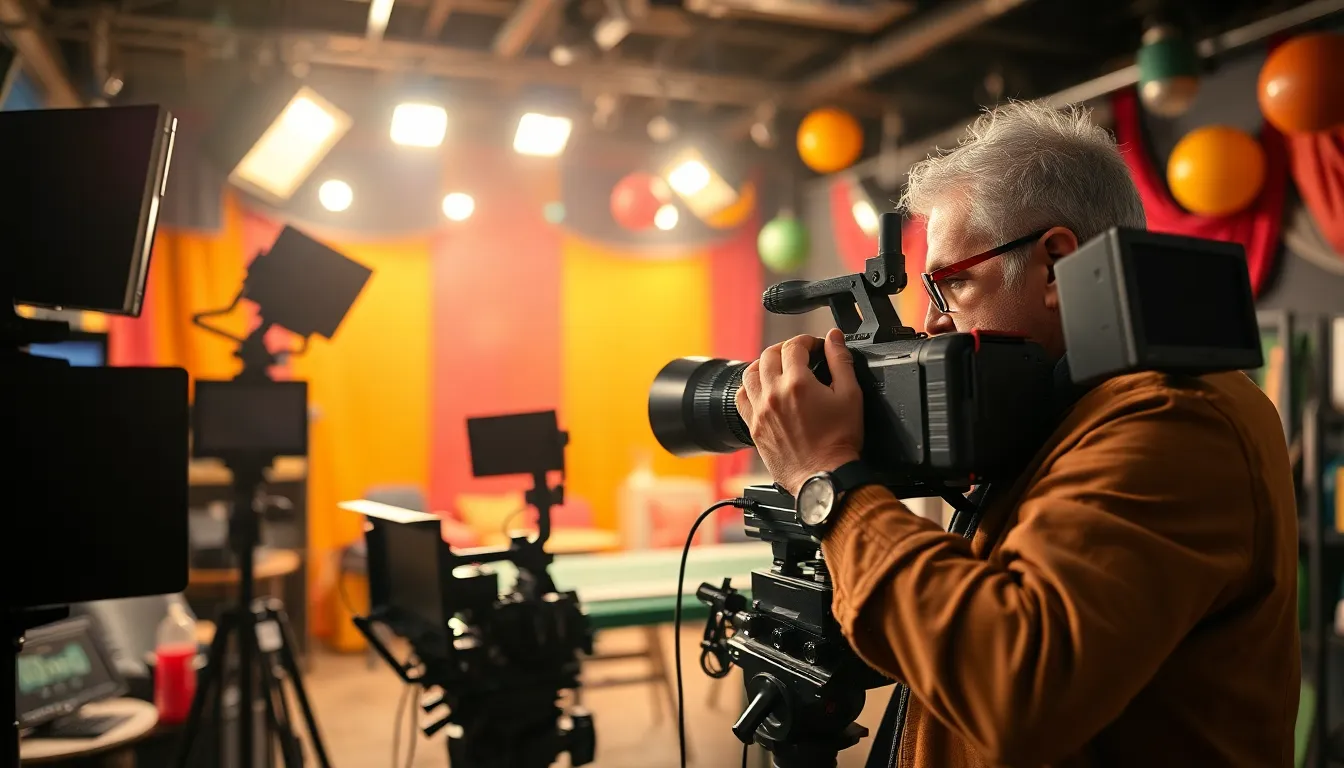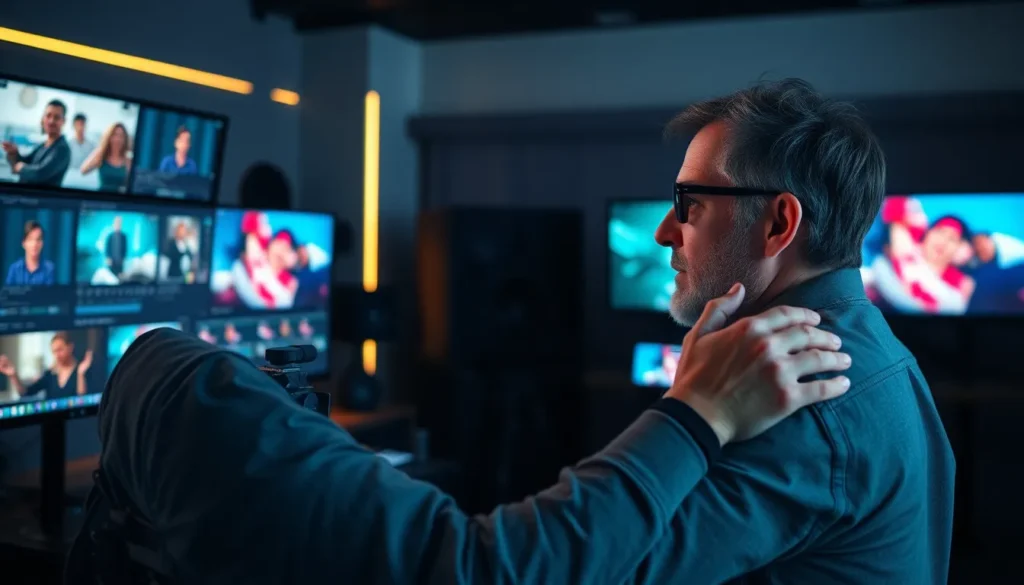In the world of cinema, film tempo is the unsung hero that can make or break a movie. It’s like the secret sauce in grandma’s famous recipe—without it, everything falls flat. Ever wondered why some films leave you breathless while others seem to drag on like a Monday morning? The rhythm of a film dictates how audiences feel, react, and even remember the story long after the credits roll.
From heart-pounding action sequences to tender, slow-motion moments, mastering film tempo is crucial for filmmakers. It’s not just about pacing; it’s about creating an emotional rollercoaster that keeps viewers glued to their seats. So, grab your popcorn and settle in as we dive into the fascinating world of film tempo, exploring how it shapes storytelling and transforms ordinary scenes into unforgettable experiences.
Table of Contents
ToggleUnderstanding Film Tempo
Film tempo plays a critical role in shaping a cinematic experience. It refers to the pace at which a story unfolds, affecting audience engagement and emotional responses.
Definition of Film Tempo
Film tempo encompasses the rhythm and timing of a movie’s scenes and sequences. This pacing affects how quickly or slowly a story progresses. Directors manipulate tempo through editing, shot duration, and scene transitions. By adjusting these elements, filmmakers establish a framework that guides viewers’ emotional reactions. Varied tempos can evoke excitement, tension, or calmness, greatly influencing audience perception.
Importance of Film Tempo in Films
Film tempo significantly impacts storytelling effectiveness. A well-paced film captivates viewers, maintaining interest throughout the narrative. Fast tempos can heighten urgency, while slower rhythms allow for reflection and emotional depth. Movies like “Mad Max: Fury Road” showcase rapid pacing that drives adrenaline, while “The Shawshank Redemption” utilizes a slower tempo to build character connections. Attention to tempo enhances overall viewer experience and enables filmmakers to create memorable cinematic moments.
Factors Influencing Film Tempo

Film tempo arises from multiple elements in filmmaking. These components work together to shape the audience’s experience throughout the narrative.
Editing Techniques
Editing techniques play a pivotal role in determining film tempo. Fast cuts create excitement, while longer takes allow for deeper emotional engagement. Directors manipulate pacing through the selection of shots, ensuring crucial moments resonate. Action sequences often benefit from quick transitions, enhancing adrenaline. Conversely, dramatic scenes may use slower edits, allowing reflection and connection. The choice of pacing impacts the overall rhythm, guiding emotional responses effectively.
Cinematography
Cinematography significantly affects film tempo, influencing how scenes unfold visually. Camera movement contributes to the pacing; for instance, rapid camera sweeps enhance tension, while static shots foster contemplation. Frame composition directs attention, establishing focus within the scene. Lighting establishes mood, impacting the viewer’s emotional response to the story. The interplay of these visual elements can accelerate or slow down the narrative, shaping the viewer’s perception.
Sound Design
Sound design creates an auditory landscape that influences film tempo. Background scores drive emotional engagement, matching the on-screen action to affect pacing. Music tempo impacts the scene’s rhythm, with faster tempos inciting excitement and slower melodies creating tension. Sound effects enhance realism, interacting with visuals to maintain pace. Dialogue delivery also contributes; rapid exchanges convey urgency, while measured dialogue builds anticipation and connection. Effective sound design complements visual and editing choices, establishing an engaging tempo throughout the film.
Film Tempo Analysis in Various Genres
Film tempo varies significantly across different genres, influencing how narratives unfold and engage audiences. Directors use tempo to align storytelling with the emotional trajectory of each film.
Action Films
Action films prioritize rapid pacing to maximize thrills and maintain viewer excitement. High-energy sequences often feature quick cuts, heightening tension and urgency. Examples like “Mad Max: Fury Road” demonstrate relentless activity, immersing viewers in chaos. Directors strategically use tempo shifts during climactic moments, allowing for brief pauses that enhance impact. This fast tempo keeps audiences on the edge of their seats, ensuring they experience a sense of exhilaration throughout the film.
Drama Films
Drama films typically adopt a slower tempo to immerse viewers in character development and emotional depth. Extended scenes allow for reflective moments, giving audiences time to connect with characters’ journeys. In “The Shawshank Redemption,” slower pacing emphasizes the themes of hope and perseverance. Moments of calm amidst tension create powerful contrasts, leading to greater emotional resonance. This careful manipulation of tempo facilitates a profound connection between the audience and the narrative.
Comedy Films
Comedy films often rely on varied tempos to enhance comedic timing and maintain audience engagement. Faster sequences deliver rapid-fire jokes, keeping the energy high and laughter frequent. Slower moments facilitate setup for punchlines, allowing audiences to fully appreciate the humor. Films like “Superbad” utilize this balance, mixing quick cuts with longer takes to build anticipation. This dynamic interplay of tempo ensures that humor lands effectively, creating a memorable viewing experience.
Impact of Film Tempo on Audience Experience
Film tempo significantly shapes how audiences experience a movie. Various elements interact to create emotional and narrative engagement, driving viewer reactions.
Emotional Engagement
Emotional engagement arises from how effectively tempo resonates with the audience. Fast-paced scenes generate excitement, often leading to adrenaline surges in thrillers or action films. Audiences experience intensified emotions during rapid cuts, as tension builds and excitement peaks. Slow tempos invite deeper reflection, allowing viewers to connect with character development and themes, as seen in drama films. Filmmakers strategically manipulate tempo to elicit specific emotional responses, enhancing the overall viewer experience. This relationship between tempo and emotions proves essential for crafting memorable moments that stay with the audience long after the credits roll.
Pacing and Storytelling
Pacing intricately weaves through the storytelling of a film. Short scenes can propel narratives quickly, often ideal for action sequences or plot twists. Longer durations provide space for character arcs to unfold naturally, enriching the audience’s understanding of motivations and emotions. An effective balance between quick transitions and deliberate pauses cultivates a rhythm, guiding viewers through the story’s highs and lows. Each scene’s timing contributes to narrative depth, ensuring that viewers remain captivated throughout. Influencing the overall arc, pacing becomes a powerful tool for filmmakers to shape storytelling and maintain audience engagement.
Film tempo is a vital element that shapes the viewer’s experience. By skillfully manipulating pacing through editing, cinematography, and sound design, filmmakers can evoke a wide range of emotions. Whether it’s the adrenaline rush from a fast-paced action scene or the reflective moments in a drama, tempo plays a crucial role in storytelling.
Understanding the nuances of film tempo allows filmmakers to create engaging narratives that resonate with audiences. As they explore different genres, the interplay of tempo can enhance emotional impact and maintain viewer interest. Ultimately, mastering film tempo is essential for crafting memorable cinematic experiences that leave a lasting impression.





